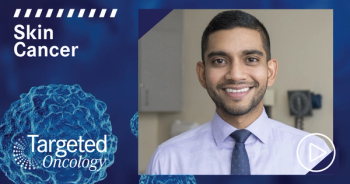
Analyzing Patient and Disease Factors in CSCC
Michael R. Migden, MD:The risk assessment for this patient includes which risk factors for aggressive disease are present. This included a larger than 2 cm diameter, a greater than 2 mm depth of involvement, a poorly differentiated tumor, and one that is eroded. Having no perineural disease in a single biopsy is not definitive, because biopsies are subject to sampling error. So, before I would say there’s no perineural involvement, I’d want to have more information, and I would get additional biopsies to see if that were the case.
In terms of staging disease and staging classifications, I am not a huge proponent of using the AJCC [American Joint Committee on Cancer] staging criteria for CSCC [cutaneous squamous cell carcinoma]. I think that it’s more important to determine whether it’s locally advanced or metastatic disease, for the purposes of consideration of systemic therapy. That’s the decision process for inclusion criteria in the phase II registration study. It’s not by stage, it’s by whether the patient has locally advanced or metastatic disease. Locally advanced disease, we know, is disease that has failed 2 or more prior surgeries, disease that has low confidence of pain and clear margins, and disease where there could be substantial morbidity or disfigurement involved. To me, that’s far more important.
The AJCC and Brigham and Women’s criteria might be better for communicating to other healthcare providers in terms of multidisciplinary management of the patient for other modalities. It’s more, in my opinion, for surgery after radiation and of less strict importance in immunotherapy.
It’s important to have multidisciplinary evaluation of patients, and the best venue for doing so is a multidisciplinary tumor board or multidisciplinary conference for evaluation and discussion, where there are physicians from each discipline present. The case can be reviewed in terms of the photograph, the imaging, the labs, and the pathology report. There can be a discussion started, and the physicians from each specialty can voice their opinion and come up with a consensus in terms of the best way forward to treat the patient.
These decisions about how to move forward with the patient with advanced CSCC are not necessarily clear-cut. I think that having a therapy that’s shown to have a good response rate that’s very tolerable means that it should be a consideration in all of these patients. There are patients who don’t want any life-threatening risk, and they believe that a large surgery, even with some disfigurement, may be a better fit for them. This might be where they just want to get on with it, and they don’t want to come for an every-2-week, every-3-week, or even every-4-week infusion or other administration, especially over a longer period of time. They do want to know that this potentially morbid surgery with or without radiation is going to give them a high cure rate, because without a disease cure, it’s harder for patients to want to go through that kind of change and that kind of consequence.
Transcript edited for clarity.
A 69-Year-Old Man With Advanced CSCC
- History and physical exam
- An otherwise healthy, 69-year-old male, fair skinned, retired construction worker, widow
- Presented to his PCP with what he described as a wound that was not healing behind his ear; he reported first noticing it at least 6 months ago and complained of recent onset of numbness in the area.
- ECOG PS 1
- The visible, ulcerated lesion was 4.5-cm in diameter and >5-mm deep
- No palpable nodes
- Biopsy confirmed a poorly-differentiated, infiltrative, postauricular cutaneous squamous cell carcinoma lesion with 7-mm invasion into subcutaneous fat.
- The recommended definitive surgical approach involved partial auriculectomy; the patient declined.
- Cemiplimab 3 mg/kg q2w was initiated







































